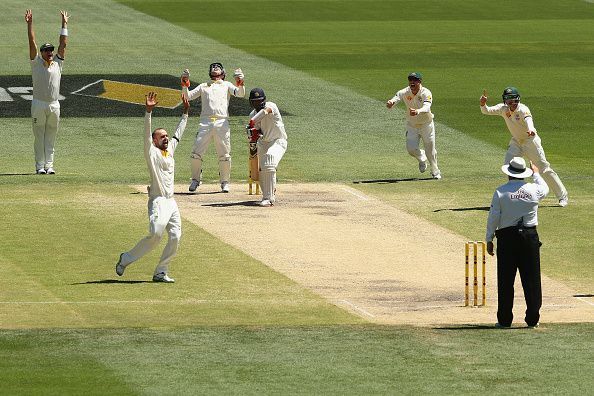
Deciphering Indian cricket team's recent struggles against spin

Sunil Gavaskar, Gundappa Viswanath, Mohammad Azharuddin, Sachin Tendulkar, Sourav Ganguly, Rahul Dravid, VVS Laxman, Virender Sehwag are traditionally known as brilliant players of spin bowling. Those were the days when the Indian batsmen made even the world's best spin bowlers toil hard for wickets on turning surfaces. The standard that was set was such that the batsmen these days have to play out of their skins to keep that reputation intact.
Unfortunately, the days when the Indian batsmen used to feast on the spinners have gone as the current lot have often succumbed against spin bowling on a handful of occasions of late. Right from Monty Panesar and Graeme Swann in 2012, the list of spin bowlers who have troubled the Indian batsmen has been on the rise. India's struggle against Moeen Ali in 2014 have made him a force to reckon with and the Test losses against Australia in Adelaide (Nathon Lyon spinning a web against the Indian batsmen), Sri Lanka in Galle (Rangana Herath winning the match single-handedly for his team) and Steve O'Keefe making the Indians pay for preparing a rank-turner in the 2017 Pune Test are some of the notable matches where the Indian batsmen failed to live up to their reputation.
While credit has to be given to the bowlers for beating the Indian batsmen at their own game, the batsmen are also at fault for giving away wickets easily to the spinners. The grit, determination and the ease with which the batsmen used to dispatch the spinners out of the attack were all but gone.
What has gone wrong? Why are the Indian batsmen, who are traditionally known to be strong against spin, struggling against that art?

One might argue that the overdose of limited-overs cricket, where the batsman is not required to be patient, and can tonk the spinners around the ground, is one of the reasons for this. Well, that might be a valid claim but the actual problem lies in the Indian regulars not playing in the domestic circuit and BCCI's scheduling of domestic matches, feels former Indian spinner, Venkatapathy Raju.
When was the last time someone like Virat Kohli played in a Ranji Trophy match? Certainly, no one is blaming Kohli or the other batsmen in the Test side for not turning up for their respective sides in Ranji Trophy as they have national commitments and they find themselves playing elsewhere or given a well-deserved rest by the BCCI to recover from fatigue.
But, this is one of the main reasons why the Indian batsmen have struggled against spinners of late.

When asked about the issue, Raju, who also served as Indian national selector in the past, said, "They are not playing domestic cricket, right? It is as simple as that. The ICC calendar is so tight and the guys are busy playing elsewhere. So, they don't have time to play domestic cricket. All the players used to play in the domestic circuit before they got picked in the Indian side. But, once they come into the national team, they are not playing much. Even if they are free, not everyone is playing because they are travelling too much, only one or two are available. Only the players who are not in contention take part in the domestic circuit regularly."
Even the batsmen who are coming into the team are having issues facing spin as the domestic matches are being played on wickets that are far from rank-turners, thanks to the neutral venue concept. Earlier, wickets in the southern parts of India used to assist the spinners more while the wickets in the northern parts tended to assist the pacers. But, ever since the neutral venue concept came into existence, home advantage was taken away and more often than not, the matches were played on wickets that rarely assisted the spinners.
"The Test matches in India are being played on turners while the domestic matches are not being played on turners. In India, the wickets will turn and if you go outside, the wickets will tend to seam and assist the fast bowlers. We do have grounds where we can plan properly. Nowadays, we play on green tops in some parts of North India but whenever teams tour India, they don't play on such wickets.
Our strength is spin and we should have spinning tracks (turners, not under-prepared wickets) even in the domestic circuit. In the past, the teams played to their strengths. If you play in the South, you will get turners in Hyderabad, Chennai etc. In the past, matches used to be played in home and away format and the hosts could prepare the kind of wicket they wanted to. That is how domestic cricket should be played," he added.

Not often do we see the absence of a turning wicket for a Test match at home. The upcoming historic Test between India and Afghanistan at the Chinnaswamy stadium in Bengaluru, which is also the Afghans' first-ever Test match, has induced fear in the Indian fans as their team will take on a quality spin-bowling attack which includes the likes of Rashid Khan, Mujeeb ur Rahman, Zahir Khan and Mohammad Nabi.
More than the hype for Afghan's first-ever Test, all eyes are on the 22-yard strip that will be given for the one-off Test as there remain concerns over the performance of the Indian batsmen against the Afghan spinners, at least among the fans, in spite of their unfamiliarity with the red ball.
It will be interesting to see the kind of wicket the hosts will dish out for the Afghanistan encounter. Irrespective of the nature of the wicket, the Team India faithful will be hoping to see their batsmen treat the spinners in the manner which will make the likes of Sehwag, Sachin, Ganguly etc. proud, something they were used to in the past.